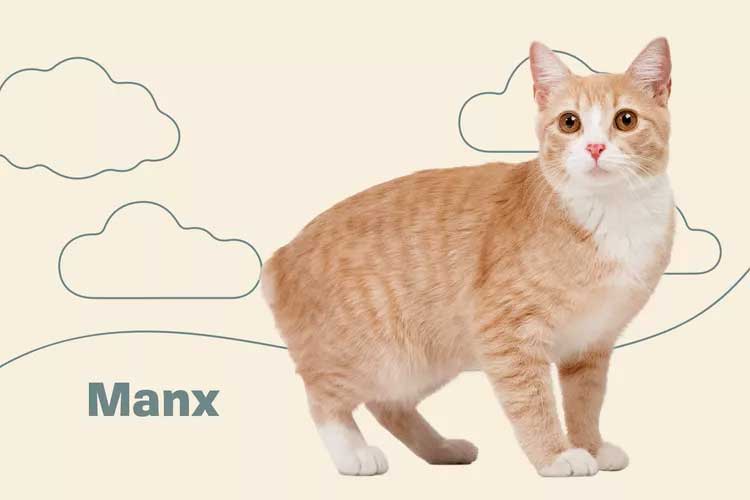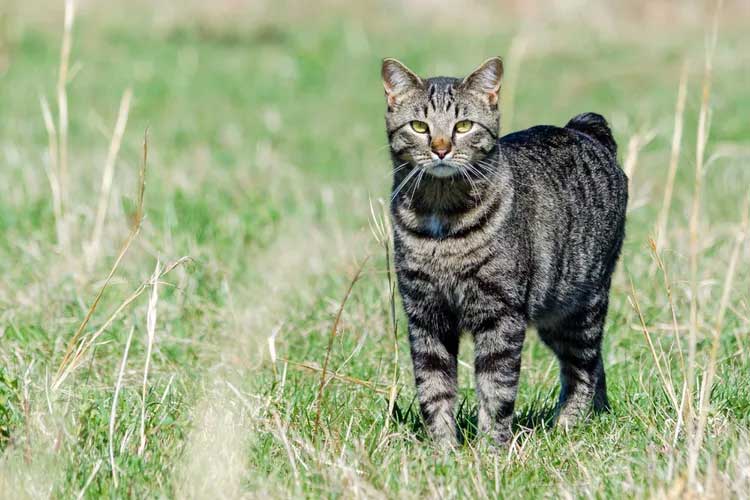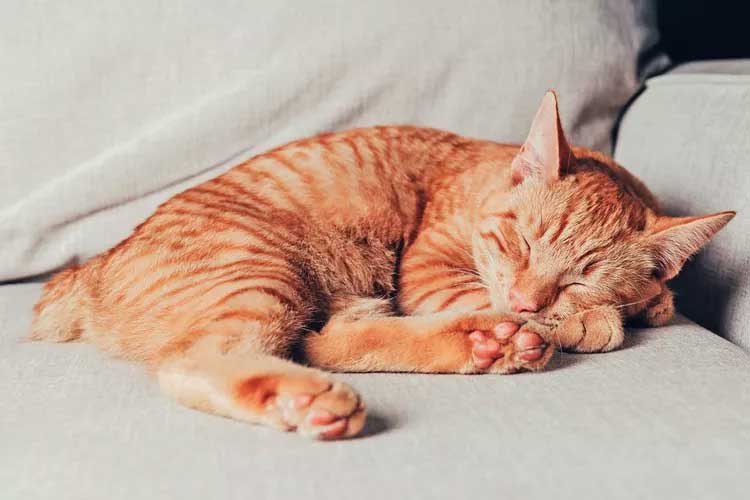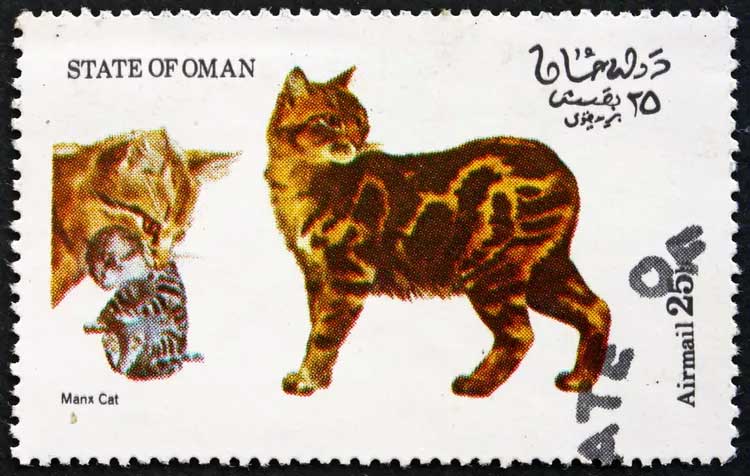With his noteworthy tailless body and sweet disposition, the Manx is a national treasure on the Isle of Man and a longtime favorite in the cat fancy.

Manx Overview
| OFFICIAL NAME | Manx |
| COMMON NAME | Manx |
| PET HEIGHT | 7 to 11 inches |
| PET WEIGHT | 8 to 12 pounds |
| LIFESPAN | 9 to 13 years |
| GOOD WITH | cats, families, seniors |
| TEMPERAMENT | affectionate |
| INTELLIGENCE | high |
| SHEDDING AMOUNT | normal |
| PLAYFULNESS | medium |
| ENERGY LEVEL | active |
| VOCAL LEVEL | when necessary |
| COAT LENGTH | short |
| COLORS | black / ebony, blue / gray, chocolate / brown / sable, cream / beige / tan, red / orange, white |
| OTHER TRAITS | friendly toward humans, high potential for weight gain, high prey drive, requires lots of grooming, tolerates being alone |
Manx cats are kind of like the diet sodas of the cat fancy: all the great cat flavor you love, now with up to 100 percent less tail.
The result of a naturally occurring genetic mutation that shortens the tail, the Manx has been the dominant cat breed on Britain's Isle of Man, a small island in the Irish Sea, for centuries. Known for their gentle, unassuming, sweet dispositions and their legendary hunting abilities, Manx have been favorites of sailors and farmers for almost as long as they've been around.
Appearance
To begin with, the word of the day for the Manx is "round." Their heads are round; their eyes are round; their ears have a rounded shape; and their hind legs are noticeably longer than their front, so their rumps rest above their front shoulders, giving them a rounded shape when they stand or move.The Manx has been described as "rabbit-like" in his movements and general appearance. This cat breed often walks by moving both hind legs in unison, giving him a kind of bunny-hopping gait.

Manx fur is thick and double-coated, making them healthy shedders, but also highly tolerant of colder weather and water. Manx cats have been found in virtually every color and pattern combination, with all-white coats or color-pointed Manx being the rarest, and orange, tabby, and tortoiseshell being the most common.
Though known to be short-haired, long-haired cats of the same genetic makeup do exist. How they are treated is a matter of some debate. The Cat Fanciers Association (CFA) says the Manx can be both long- or short-haired, but exhibits them all as short hairs, regardless of actual coat length. Other governing bodies in Europe and Asia list the long-haired cats as a separate breed, called the Cymric.
The Manx's lack of tail is the result of a naturally occurring genetic mutation. This, coupled with the Isle of Man's small size and geographic isolation, allowed the dominant-gene trait to run rampant among the Isle's cat population.
Despite their reputation for taillessness, Manx cats can actually manifest in one of five categories:
Rumpy (or rumpie): These cats have no tail at all, though a tuft of hair where the tail would have grown is not uncommon.
Riser or rumpy riser: Cats that have a bump of cartilage under the fur. When the cat is happy or their rumps are petted, this bump will often rise.
Stumpy (stumpie): Cats that are born with a partial tail of vestigial, fused vertebrae, usually around an inch in length.
Stubby (stubbie), shorty, or short-tailed: A Manx with a short tail of non-fused bones, up to about half an average cat tail. Aside from their length, these tails can move and operate exactly like a regular tail.
Longy (longie) or taily (tailie): Manx with a half to normal-length tail.
In competition, only rumpies to stumpies are eligible to show under the Manx category. In the CFA, stubbies and longies are still eligible to show, but under the "any other" category. They are both, however, important in breeding stock, as mating two rumpies together can cause serious health problems.
Temperament
The Manx is a sweet-tempered, easygoing cat. While possessing a strong independent streak, they are loyal to their family units, often following their favorite humans around the house."Generally speaking, they are pretty social; they're pretty intelligent and playful," says Bruce Kornreich, DVM, PhD, director of the Cornell Feline Health Center. "Some people have claimed that they can be a little bit dog-like, that they can learn to fetch things and they might be amenable to being taught verbal commands, things like that."
Manx are also renowned hunters, having been used commonly as ratters on ships of all sizes and prized by farmers for their prey drive and ability to hunt larger prey, like rats and voles.
Living Needs
A Manx doesn't have a ton in the way of special requirements or desires. They are moderately active cats who will enjoy playing fetch and can be trained to understand vocal commands and clicker cues with relative ease. They're adept jumpers and natural hunters, more so than explorers, so if your Manx disappears for a while, she's probably on the scent of something.Families and multi-pet homes will find Manx to be an affable, sweet-tempered addition—as long as they are introduced to their new furry siblings gradually.

Kornreich says it's important to give a new cat a space to feel comfortable in.
"Give the cat a place where he or she could retreat to and feel safe in, so a room with a litter box, food and water bowls, that sort of thing," he says. He recommends keeping the new kitty inside that space while gradually making introductions through scent and then sight.
"What's probably the most important with [introducing] cats and children is letting the cat learn to come over to the child rather than the other way," Kornreich continues. "Because children tend to get excited, and they may do something like try to pick the cat up, or grab something, or corner the cat, which could be a problem. I think a reasonable thing would be to let the cat come over to the child and rewarding the cat for good behavior. Perhaps letting the child provide treats. Verbal positive reinforcement for good activities is important."
Care
The Manx's double coat tends to require fairly constant care. Brushing daily is the most effective way of keeping loose hair to a minimum and keeping coats looking smooth and free of tangles. Expect the shedding seasons to be especially fun, as both coats (long and short) drop a bit of mass.
As with all cats, you need to keep your Manx's nails trimmed so he doesn't click-clack across the floor or accidentally scratch you while making biscuits. Keep his litter box clean, and make sure he has access to toys to hunt and scratch on so he doesn't grow bored.
Health
When it comes to a Manx's health, there are issues tied specifically to his taillessness that should be kept in mind. The biggest health concern, Kornreich says, is Manx syndrome."Manx syndrome" is a colloquial name for a condition that results when the tailless gene shortens the spine too much. This can result in seriously damaged spinal cord nerves leading to problems with the bowels, bladder, and gastrointestinal tract. This can cause issues like incontinence or constipation, depending on the extent of the damage and which parts of the GI tract are affected, Kornreich says.
Some Manx with partial tails are prone to a form of arthritis that can be painful. Those with stubby tails can also be predisposed to bacterial infections in the fold of their tail, Kornreich says.
The breed is also predisposed to a genetic condition called corneal dystrophy, where the cornea develops abnormally.
Finally, some tailless cats such as the Manx may develop megacolon, which is a recurring condition (a dilated, flaccid colon) causing constipation that can be life-threatening to the cat if not properly monitored.
History
The Manx has existed for centuries on the Isle of Man. While their exact origin is a matter of some debate, they were almost certainly created when a cat with a spontaneous short-tailed mutation was introduced to the island, most likely by either Nordic or Spanish sailors. Due to the island's small size and relative isolation from the mainland, combined with the mutation's high degree of penetration, the Manx gene became the dominant trait among the island's cat population.
"There's still work going into what specifically causes taillessness, which are unique to the Manx breed—what's the genetic mechanism of the suppressed tail length, what genes control tail length," Kornreich says. "There is a taillessness gene that's been kind of identified, but it only determines whether the tail will be there or not. It doesn't talk about how much because Manx cats can have tails of varying lengths, from no tail to a stub to sort of a half-tail, in some cases they might have sort of a normal-length tail."
The Manx is not the only short-tailed cat in the world, nor are all non-tailed cats automatically Manx. Breeds like the Japanese bobtail are thought to have been created in a similar fashion (genetic mutation meets geographic isolation) but developed independently.
Manx have existed for at least three centuries, having been first recorded in 1807 and written about as a well-established breed. When the CFA was founded in 1904, the Manx was one of the founding breeds.
Fun Facts
Thanks to their distinct appearance, the Manx has been a favorite character in literature, film, and television. Some notables include Mac Manc McManx from the comic strip "Get Fuzzy," Manx Cat, the antagonist in Paul Gallico's 1968 children's novel Manxmouse: The Mouse Who Knew No Fear, and the titular Stimpy from "The Ren & Stimpy Show"The Norton Manx motorcycle line used Manx cat badges to promote their brand, in the forms of both enameled metal pins and sew-on patches.
The Meyers Manx, the original Volkswagen Beetle-based dune buggy, was named after the cat due to its stubby, short-bodied design.
A popular flying model aircraft of the late 1950s was the Manx Cat, sold in kit form as the Manx Cat V. Constructed of balsa wood, the plane features a very short tail (thus the name).